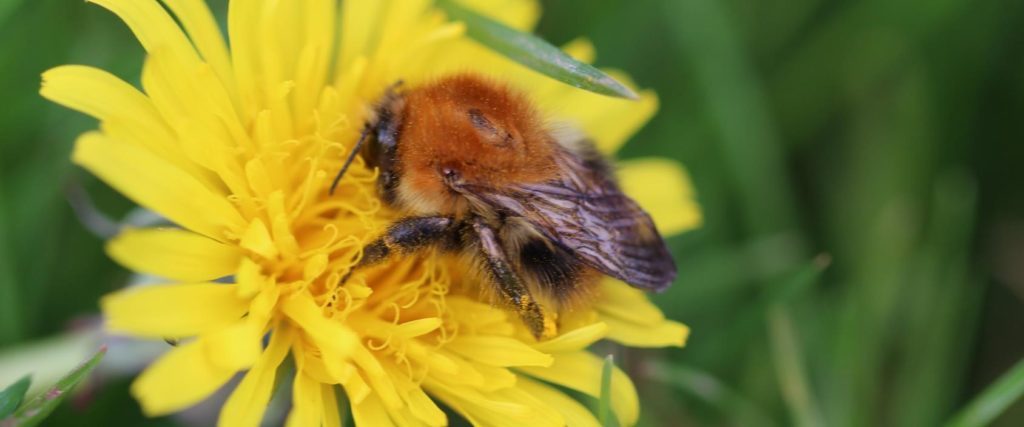Like any organism, bees have diseases. In honey bees, there are treatments against the Varroa mite. With other diseases, beekeepers can give some help. Like choosing the right place for the apiary, the flower diversity etc. Which I usually sum up with “good practices”. Non-managed bees, however, have to deal with their parasites and pathogens without human help. This doesn’t mean they’re completely helpless: They may actively search for cures or preventions. This self-medication in bees is an interesting aspect of bee health.
But how does this work? So-called secondary metabolites could be an element of this. Plants produce these substances to protect themselves against herbivores. Some examples are nicotine, caffeine, or solanine (in tobacco, coffee, and potatoes). These substances are toxic for herbivores. On the other hand, they may also protect them against parasites. Nectar and pollen often contain these substances. This could indicate that they have the same function also for pollinators. In fact, there is some evidence that this may be the case.
Some indications of self-medication in bees
Self-medication in bees is a deliberate behaviour, they actively search for a cure or prevention against parasites and pathogens. It doesn’t happen by chance. Many wouldn’t attribute such a complex behaviour to insects. Honey bees, for instance, collect resin from plants and transform it into propolis. The workers line the interior of the hive with a thin layer of it as a protection for the nest. Actually, the name itself indicates protection: “propolis” means “in front of the city” or “in defence of the city”. It acts against bacteria, fungi and even viruses. But the question remains: Is this a purposeful behaviour? Or just something that produced a coincidental benefit to the colonies?
There is some evidence for the former: Simone-Finstrom and Spivak made experiments challenging colonies with chalkbrood. It is caused by a fungal pathogen of the brood. In the final stage, it completely covers the larva, forming typical “mummies”. In response to this, the colonies actively collected more plant resins – fulfilling the requirement of intentional behaviour. They found fewer “mummies” in propolis-rich colonies than in those with less resin. This shows that this behaviour helps against the pathogen and serves as an example of self-medication in bees.
But let’s come back to the secondary metabolites in the nectar. Do they help bees against bee parasites? There is some evidence for this, too. In laboratory experiments, bumblebees infected with Crithidia bombi (a gut parasite) preferred sugar syrup with nicotine. This substance did not cure the infestation but delayed it. The effect on the parasite was relatively weak, but the authors suggest subtle benefits for the host fitness or their colonies. However, it may count as a supportive measure. Later research showed that nicotine in the nectar helps bumblebees to learn floral features. This could support that they search for these substances intentionally.
Another group of scientists tested a total of eight nectar chemicals against the same parasite. In the lab, four of these secondary metabolites reduced the load of C. bombi from 61-81%. However, even the most efficient chemical, anabasine, did not mitigate the negative effects of the parasite on the individual. The infested bees also didn’t drink more sugar solution with this chemical. The results, therefore, aren’t explicit, but there is a hint for self-medication in bees that surely is worth further study.
What about solitary bees?
There isn’t much evidence if the same mechanisms are active also for solitary bees. However, there may be a relationship between specializing in certain plants and parasitism. Feeding their brood with pollen from defined plant species (so-called oligolectic bees) may also help to avoid parasitism. Dakota Spear and her co-authors discuss some Osmia species oligolectic on plants of the daisy family. The pollen of these plants has low nutritive value, but may protect the offspring from cleptoparasites. These authors suggest that it’s an advantage to feed on lower-quality pollen, if this keeps parasites away.
It would be interesting to know if the pollen of other plant species has the same effect and if this influenced the evolution of other oligolectic species. Solitary bees are generally understudied; also concerning their behaviour preventing diseases. Considering most recent research, however, this question becomes more urgent. If diverse bee communities “dilute” pathogens and parasites, knowing more about solitary bee health issues is crucial. It may also help to improve managed honey bee health. In any case, it stresses how important bee nutrition is for their health.



